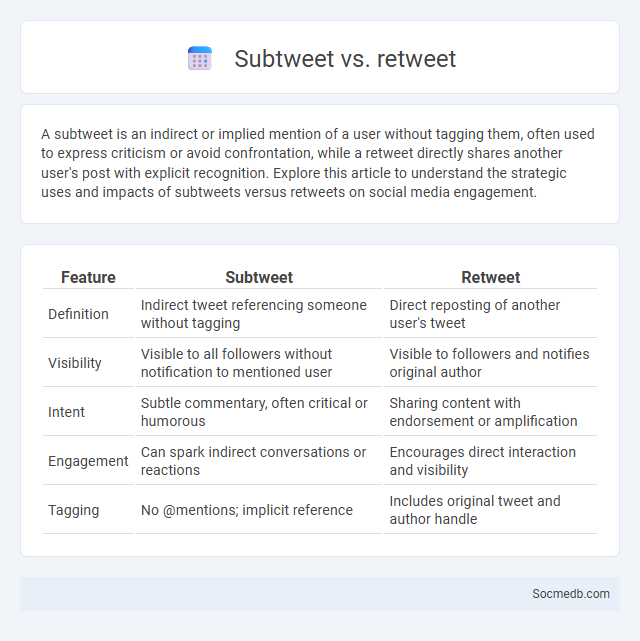
Photo illustration: Subtweet vs Retweet
A subtweet is an indirect or implied mention of a user without tagging them, often used to express criticism or avoid confrontation, while a retweet directly shares another user's post with explicit recognition. Explore this article to understand the strategic uses and impacts of subtweets versus retweets on social media engagement.
Table of Comparison
| Feature | Subtweet | Retweet |
|---|---|---|
| Definition | Indirect tweet referencing someone without tagging | Direct reposting of another user's tweet |
| Visibility | Visible to all followers without notification to mentioned user | Visible to followers and notifies original author |
| Intent | Subtle commentary, often critical or humorous | Sharing content with endorsement or amplification |
| Engagement | Can spark indirect conversations or reactions | Encourages direct interaction and visibility |
| Tagging | No @mentions; implicit reference | Includes original tweet and author handle |
Understanding the Basics: Subtweet vs Retweet
Understanding the basics of social media interactions helps enhance your online communication strategy. A retweet is a direct rebroadcast of someone else's tweet to your followers, amplifying the original message with credit, while a subtweet indirectly references another user without tagging, often conveying criticism or commentary subtly. Recognizing these differences allows you to use each tool effectively for engagement or nuanced conversation.
What is a Subtweet?
A subtweet is a tweet that references someone indirectly without mentioning their username, often used to express opinions or criticism subtly. This form of communication relies on context and shared knowledge among followers to understand the target. Subtweeting can fuel discussions or conflicts while maintaining plausible deniability on platforms like Twitter.
What is a Retweet?
A retweet is a social media action on Twitter that allows you to share another user's tweet with your followers, amplifying its reach. This feature helps spread important news, trends, or opinions quickly across the platform by reposting content without altering the original message. Your engagement through retweets can increase visibility and influence within your network.
Key Differences Between Subtweet and Retweet
Subtweet refers to posting indirect or vague messages about a person without mentioning their username, often used for subtle criticism or commentary. Retweet, on the other hand, involves sharing another user's tweet directly on your own timeline, with or without additional comments, emphasizing content amplification. The key difference lies in intent and visibility: subtweets maintain ambiguity and indirect communication, while retweets promote explicit information sharing and engagement.
The Purpose of Subtweeting
Subtweeting serves as an indirect method of communication on social media platforms, allowing users to express opinions or criticisms without explicit tagging. This practice fosters ambiguous engagement, prompting followers to interpret or identify the subject, enhancing intrigue and social dynamics. The purpose often revolves around addressing conflicts or garnering attention while maintaining plausible deniability.
The Role of Retweets in Social Media
Retweets significantly amplify the reach of your social media content by allowing your message to spread beyond your immediate followers, increasing engagement and visibility. They serve as social proof, signaling to others that your content is valuable and worthy of sharing, which can enhance your online credibility and influence. Leveraging retweets strategically can boost your brand presence, drive traffic, and foster a wider community around your social media profiles.
Subtweeting: Pros, Cons, and Examples
Subtweeting involves posting indirect messages on social media platforms like Twitter to reference someone without tagging them, fostering subtle communication and indirect conflict resolution. Pros include expressing feelings discreetly and engaging followers through intrigue, while cons involve misunderstandings, passive-aggressive tones, and potential escalation of conflicts. Examples include vague complaints or sarcastic remarks aimed at individuals, driving engagement through curiosity but risking backlash or damaged relationships.
Retweeting: Pros, Cons, and Examples
Retweeting on social media platforms like Twitter amplifies content reach, enhancing engagement and visibility for individuals and brands. However, it can lead to misinformation spread, loss of content control, and potential association with unintended messages. Effective retweeting strategies include sharing relevant industry news, user-generated content, and timely updates to foster community interaction and trust.
Social Media Etiquette: When to Subtweet or Retweet
Subtweeting can subtly address issues without direct confrontation, but it risks misinterpretation and damaging relationships if not used carefully. Retweeting shares valuable content or opinions with your followers, enhancing engagement and credibility on platforms like Twitter. Your choice between subtweeting and retweeting should consider the context and desired impact on your personal or professional digital presence.
Choosing Between Subtweet and Retweet: Best Practices
Choosing between subtweet and retweet depends on your communication goals and audience engagement. Subtweeting allows you to address a topic indirectly, preserving anonymity and inviting curiosity, while retweeting amplifies existing content and fosters direct interaction with original posts. Your strategic use of subtweets and retweets enhances social media presence by balancing subtle commentary with clear endorsement.
 socmedb.com
socmedb.com